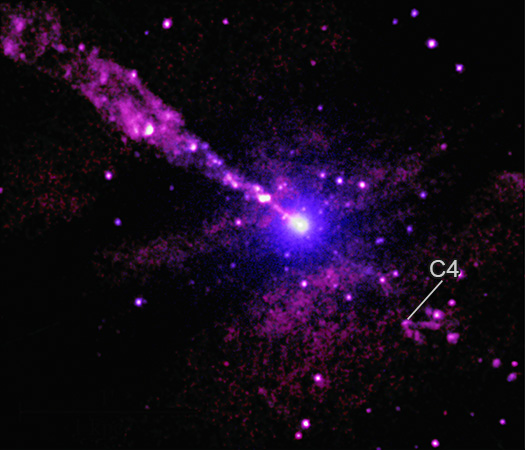Even matter ejected by black holes can run into objects in the dark. Using NASA’s Chandra X-ray Observatory, astronomers have found an unusual mark from a giant black hole’s powerful jet striking an unidentified object in its path.
The discovery was made in a galaxy called Centaurus A (Cen A), located about 12 million light-years from Earth. Astronomers have long studied Cen A because it has a supermassive black hole in its center sending out spectacular jets that stretch out across the entire galaxy. The black hole launches this jet of high-energy particles not from inside the black hole, but from intense gravitational and magnetic fields around it.
The image shows low-energy X-rays seen by Chandra represented in pink, medium-energy X-rays in purple, and the highest-energy X-rays in blue.
In this latest study, researchers determined that the jet is — at least in certain spots — moving at close to the speed of light. Using the deepest X-ray image ever made of Cen A, they also found a patch of V-shaped emission connected to a bright source of X-rays, something that had not been seen before in this galaxy.
Called C4, this source is located close to the path of the jet from the supermassive black hole and is highlighted in the inset. The arms of the “V” are at least about 700 light-years long. For context, the nearest star to Earth is about 4 light-years away.

While the researchers have ideas about what is happening, the identity of the object being blasted is a mystery because it is too distant for its details to be seen, even in images from the current most powerful telescopes.
The incognito object being rammed may be a massive star, either by itself or with a companion star. The X-rays from C4 could be caused by the collision between the particles in the jet and the gas in a wind blowing away from the star. This collision can generate turbulence, causing a rise in the density of the gas in the jet. This, in turn, ignites the X-ray emission seen with Chandra.
The shape of the “V,” however, is not completely understood. The stream of X-rays trailing behind the source in the bottom arm of the “V” is roughly parallel to the jet, matching the picture of turbulence causing enhanced X-ray emission behind an obstacle in the path of the jet. The other arm of the “V” is harder to explain because it has a large angle to the jet, and astronomers are unsure what could explain that.
This is not the first time astronomers have seen a black hole jet running into other objects in Cen A. There are several other examples where a jet appears to be striking objects — possibly massive stars or gas clouds. However, C4 stands out from these by having the V-shape in X-rays, while other obstacles in the jet’s path produce elliptical blobs in the X-ray image. Chandra is the only X-ray observatory capable of seeing this feature. Astronomers are trying to determine why C4 has this different post-contact appearance, but it could be related to the type of object that the jet is striking or how directly the jet is striking it.
A paper describing these results appears in a recent issue of The Astrophysical Journal. The authors of the study are David Bogensberger (University of Michigan), Jon M. Miller (University of Michigan), Richard Mushotsky (University of Maryland), Niel Brandt (Penn State University), Elias Kammoun (University of Toulouse, France), Abderahmen Zogbhi (University of Maryland), and Ehud Behar (Israel Institute of Technology).
NASA's Marshall Space Flight Center in Huntsville, Alabama, manages the Chandra program. The Smithsonian Astrophysical Observatory's Chandra X-ray Center controls science operations from Cambridge, Massachusetts, and flight operations from Burlington, Massachusetts.
This release features a series of images focusing on a collision between a jet of matter blasting out of a distant black hole, and a mysterious, incognito object.
At the center of the primary image is a bright white dot, encircled by a hazy purple blue ring tinged with neon blue. This is the black hole at the heart of the galaxy called Centaurus A. Shooting out of the black hole is a stream of ejected matter. This stream, or jet, shoots in two opposite directions. It shoots toward us, widening as it reaches our upper left, and away from us, growing thinner and more faint as it recedes toward the lower right. In the primary image, the jet resembles a trail of hot pink smoke. Other pockets of granular, hot pink gas can be found throughout the image. Here, pink represents low energy X-rays observed by Chandra, purple represents medium energy X-rays, and blue represents high energy X-rays.
Near our lower right, where the jet is at its thinnest, is a distinct pink "V", its arms opening toward our lower right. This mark is understood to be the result of the jet striking an unidentified object that lay in its path. A labeled version of the image highlights this region, and names the point of the V-shape, the incognito object, C4. A wide view version of the image is composited with optical data.
At the distance of Cen A, the arms of the V-shape appear rather small. In fact, each arm is at least 700 light-years long. The jet itself is 30,000 light-years long. For context, the nearest star to the Sun is about 4 light-years away.
|
||||||||||||||||||||||||||||||


